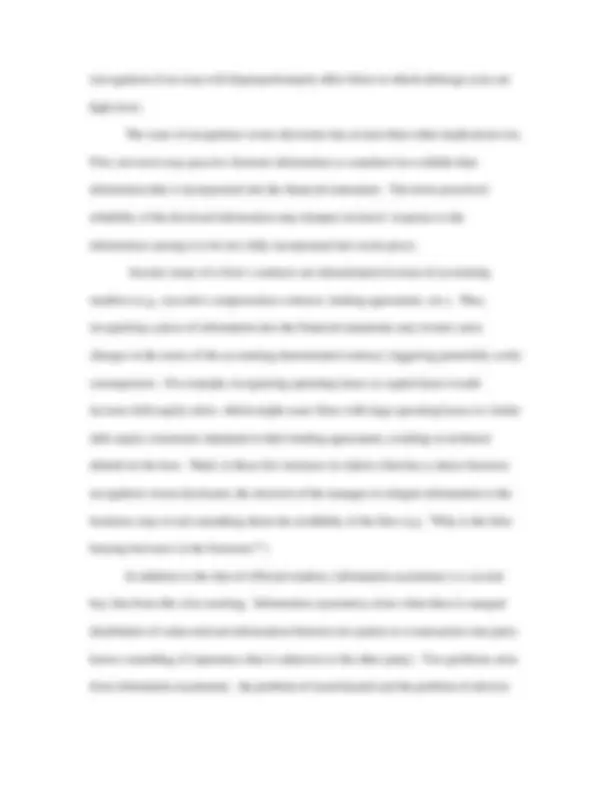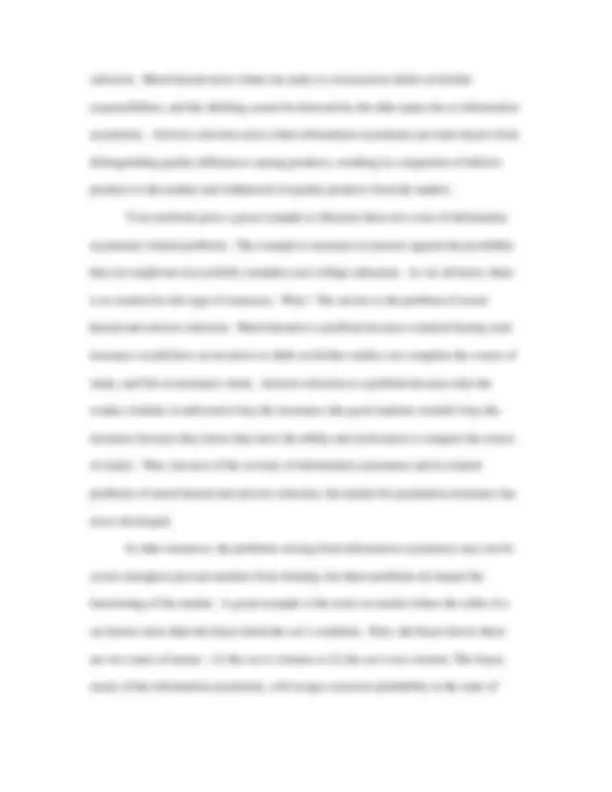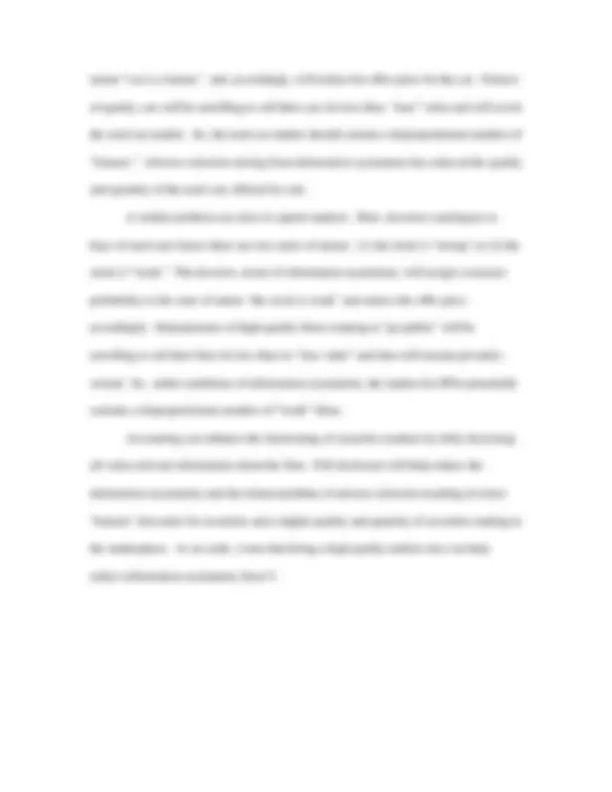





Study with the several resources on Docsity

Earn points by helping other students or get them with a premium plan


Prepare for your exams
Study with the several resources on Docsity

Earn points to download
Earn points by helping other students or get them with a premium plan
Community
Ask the community for help and clear up your study doubts
Discover the best universities in your country according to Docsity users
Free resources
Download our free guides on studying techniques, anxiety management strategies, and thesis advice from Docsity tutors
Material Type: Notes; Professor: Boone; Class: Financial Accounting Theory; Subject: Accounting; University: University of Texas - San Antonio; Term: Fall 2008;
Typology: Study notes
1 / 6

This page cannot be seen from the preview
Don't miss anything!




Summary of Key Ideas from 9/16/08 Class
There are two key ideas from the 9/16 class meeting: The idea of informationally efficient capital markets (EMH/IRH) and the role of information asymmetry. The early version of the Efficient Market Hypothesis (EMH) asserts that at all times stock prices reflect all publicly available information. Hence, stock prices are “fully informative” and there are no undervalued securities. The logic behind the EMH is the presence of arbitrageurs who quickly act on any piece of value relevant information about a security (buying if the information is good news; selling if it is bad news). Their act of buying (selling) puts upward (downward) pressure on stock prices causing them to gravitate toward full-information value. However, this poses a logical inconsistency: if stock prices fully reflect all public information, what incentive is there for information search? Lacking such incentive, arbitrageurs would cease their information search efforts and stock prices would no longer fully reflect all publicly available information. The way out of this logical inconsistency is to recognize the role of noise traders. Noise traders are those investors who trade on the basis of liquidity needs (liquidate a position to get cash for some consumption purposes, or take a position to invest excess cash), “pseudo-signals” (a “hot” tip), or on the basis of some whim. Trades executed by noise traders can cause stock prices to temporarily deviate from full information value, creating an incentive for the arbitragers to engage in information search. If the information search reveals that noise trade has moved stock prices above full information value (stock is overvalued), the arbitrageur will sell short. Alternatively, if the
arbitrageur concludes that an increase in stock price is due to some other arbitrageur buying based on newly discovered information, the arbitrageur will buy the stock. Given the presence of both arbitrageurs and noise traders, we say that stock prices are partially informative. That is, investors can expect that, on average, stock prices fully reflect all publicly available information, but further investigation may reveal this is not the case. The cost of arbitrage is an important determinant of the extent to which stock prices will reflect publicly available information. Arbitrage costs include transaction costs (the cost of placing the order, the spread between bid and ask prices, etc.), holding costs, and information acquisition and processing costs. In settings where arbitrage costs are high, stock prices (in general) will reflect a smaller portion of publicly available information than when arbitrage costs are low. This is the Incomplete Revelation Hypothesis (IRH), which is essentially a “tweak” on the original EMH. This insight has important implications for accounting policy—most notably, the issue of recognition versus disclosure. If one ignores arbitrage costs and adopts a simplistic view of market efficiency (i.e., the early version of EMH), then the issue of recognition versus disclosure is moot: whether an item is recognized in the financials proper or merely disclosed in the footnotes is irrelevant because the market will properly act upon the information causing the information to be impounded in stock prices. However, once we recognize that information disclosed in footnotes may be more costly to acquire and process, then it is possible that information disclosed in the footnotes may be less fully incorporated in stock prices than information that is recognized in the financial statements. So, policymakers might want to opt in favor of recognition (disclosure) rather than disclosure
selection. Moral hazard arises when one party to a transaction shirks on his/her responsibilities, and the shirking cannot be detected by the other party due to information asymmetry. Adverse selection arises when information asymmetry prevents buyers from distinguishing quality differences among products, resulting in a migration of inferior products to the market and withdrawal of quality products from the market. Your textbook gives a great example to illustrate these two sorts of information asymmetry related problems. The example is insurance to protect against the possibility that you might not successfully complete your college education. As we all know, there is no market for this type of insurance. Why? The answer is the problem of moral hazard and adverse selection. Moral hazard is a problem because a student buying such insurance would have an incentive to shirk on his/her studies, not complete the course of study, and file an insurance claim. Adverse selection is a problem because only the weaker students would tend to buy the insurance (the good students wouldn’t buy the insurance because they know they have the ability and motivation to compete the course of study). Thus, because of the severity of information asymmetry and its related problems of moral hazard and adverse selection, the market for graduation insurance has never developed. In other instances, the problems arising from information asymmetry may not be severe enough to prevent markets from forming, but these problems do impair the functioning of the market. A good example is the used car market where the seller of a car knows more than the buyer about the car’s condition. Here, the buyer knows there are two states of nature: (1) the car is a lemon or (2) the car is not a lemon. The buyer, aware of the information asymmetry, will assign a nonzero probability to the state of
nature “car is a lemon,” and, accordingly, will reduce his offer price for the car. Owners of quality cars will be unwilling to sell their cars for less than “true” value and will avoid the used car market. So, the used car market should contain a disproportionate number of “lemons.” Adverse selection arising from information asymmetry has reduced the quality and quantity of the used cars offered for sale. A similar problem can arise in capital markets. Here, investors (analogous to buys of used cars) know there are two states of nature: (1) the stock is “strong” or (2) the stock is “weak.” The investor, aware of information asymmetry, will assign a nonzero probability to the state of nature “the stock is weak” and reduce the offer price accordingly. Entrepreneurs of high-quality firms wanting to “go public” will be unwilling to sell their firm for less than its “true value” and thus will remain privately- owned. So, under conditions of information asymmetry, the market for IPOs potentially contains a disproportionate number of “weak” firms. Accounting can enhance the functioning of securities markets by fully disclosing all value-relevant information about the firm. Full disclosure will help reduce the information asymmetry and the related problem of adverse selection resulting in lower “lemons” discounts for securities and a higher quality and quantity of securities trading in the marketplace. As an aside, I note that hiring a high quality auditor also can help reduce information asymmetry (how?)